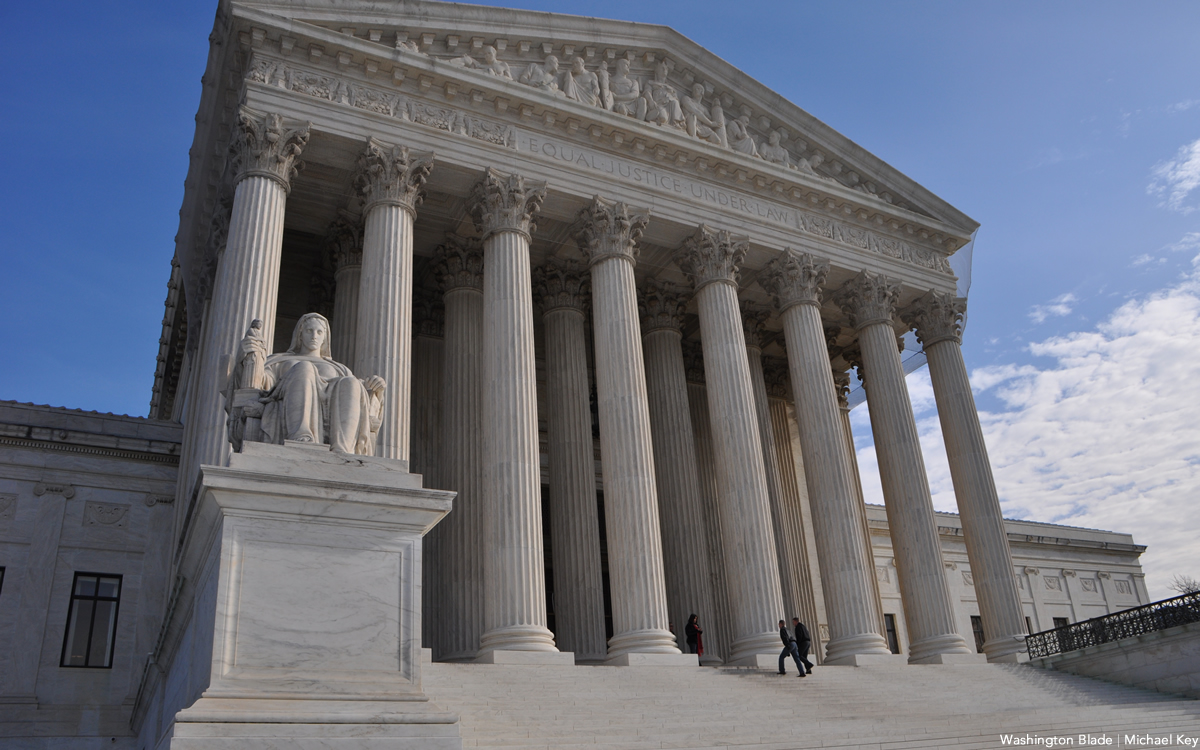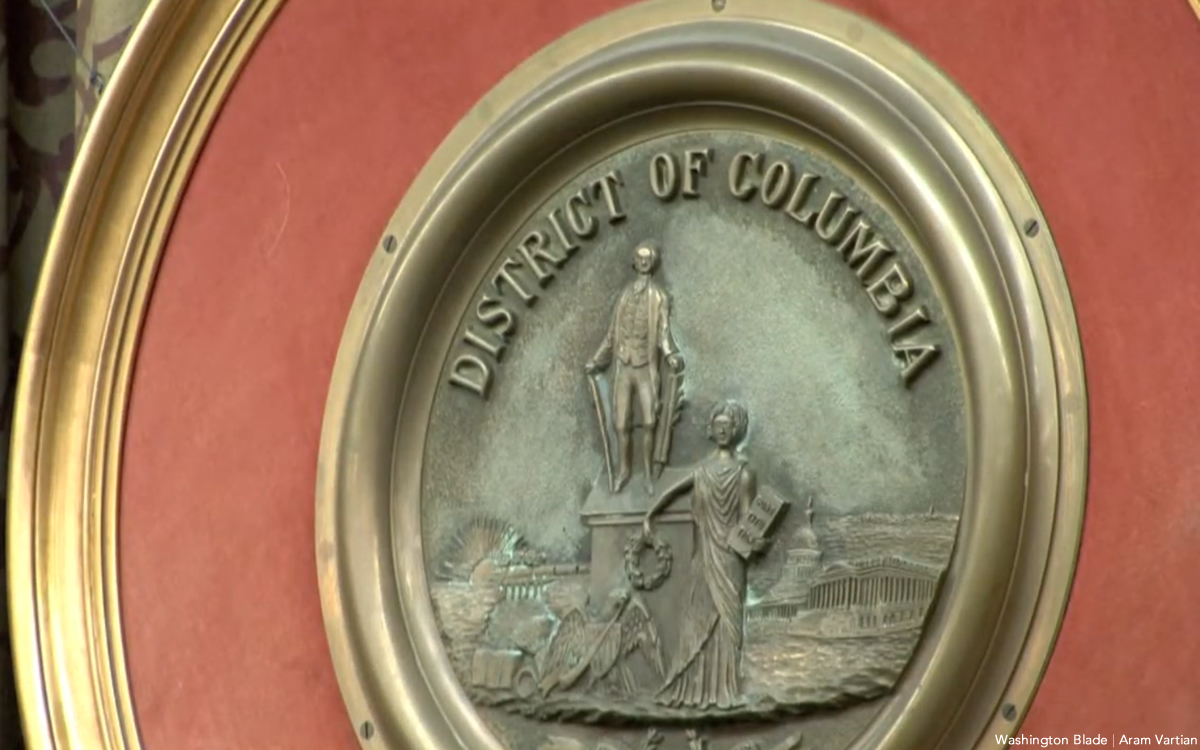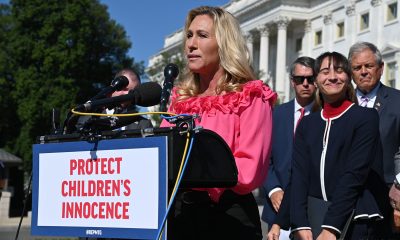Opinions
Out with 2021 and in with 2022
Here’s to a future for all with health, hope, happiness, and peace

As we bring 2021 to a close I think back on the highlights, the low lights and those times we just managed to live our lives day-to-day. For many of us that was the majority of the time. I look forward with hope to 2022.
The year 2021 began with the Jan. 6 insurrection. Those of us in D.C. lived with armed national guard troops on the streets for weeks. We had the weird experience of actually thanking Vice President Pence for something — doing the right thing. Then came Jan. 20 and the inauguration of President Joe Biden and Vice President Kamala Harris. It was a glorious day bringing hope for a better year. Lady Gaga sang and Amanda Gorman recited her poem “The Hill We Climb.” It seemed to all a new day had finally begun. But it wasn’t to be an easy time and Trumpism is always in the background.
President Biden proposed his broad economic agenda, still not completed, but there is hope much of it will happen. Many of the promises he was elected on will be honored.
Politics continue to be nasty and Republicans continue to be the Party of No. Many of their members on the Hill are both disgusting and frightening. School shootings continue with the most recent one in Oxford, Mich., the 28th this year.
For most of us, 2021 was the year we kept hoping the pandemic would finally abate. We prayed we could get our lives back to normal and once again hug and kiss our family and friends without worrying about catching COVID. For many of us getting the booster shot was the key to that. We know there will continue to be COVID but as I write this we are hearing the booster shot will protect us against the newest variant, Omicron. That gives me hope as we enter 2022.
While not back to normal there is a feeling some things are better. Friends just returned from a trip to New York City and said it’s crowded once again. Restaurants and theaters are packed. In D.C .walking down 17th Street or 14th Street, you see crowds once again. One of the best things to come from the pandemic are all the new eateries, outdoor seating for restaurants. They are packed with diners and when it’s cold they have heaters the city helped fund. By all accounts Mayor Muriel Bowser helped keep D.C. functioning and mostly safe during this past year. Clearly it hasn’t been easy but through perseverance her policies seem to be working. Now we just need more people vaccinated, more back in their offices and more tourists arriving, which will once again make for a thriving downtown.
The highlight of my year was a transatlantic cruise on the incredible Celebrity APEX. Getting to Barcelona to meet the ship was my first time on an airplane since March 2020 and there was something liberating about that. After a few days in that city, where about 80 percent of the population was vaccinated and no one questioned wearing a mask indoors and on public transportation, I felt very safe. Arriving back in time to see Democrats lose all statewide races in Virginia and nearly lose the governorship in New Jersey was not a pretty way to end the year.
I look forward with a positive attitude to 2022. I will spend New Year’s Eve with friends in Rehoboth Beach as I have for many years. I have continued hope the owners of bars and restaurants at the beach will do what’s being done in New York, LA and by many in D.C. and other cities asking for proof of vaccination from their patrons even if it isn’t mandated by government. Not holding my breath for the Rehoboth Beach Commission to mandate it.
Once the ball comes down in Times Square and it’s 2022, Democrats will surely enact some form of the Build Back Better bill so President Biden can talk about all he has done for the people one year into his administration when he gives a report to the nation during his State of the Union speech. In addition to all the domestic advances it will be the first time in 20 years the nation is not at war.
So here’s a toast to 2022, to family and friends, old and new. To remembering those no longer with us and to seeing a future for all with health, hope, happiness and peace on earth.
Peter Rosenstein is a longtime LGBTQ rights and Democratic Party activist. He writes regularly for the Blade.
Opinions
New research shows coming out is still risky
A time of profound psychological vulnerability

Coming out is often celebrated as a joyful milestone – a moment of truth, pride, and liberation. For many LGBTQ+ people, that’s exactly what it becomes. But new research I co-authored, published in the journal Pediatrics this month, shows that the period surrounding a young person’s first disclosure of their sexual identity is also a time of profound psychological vulnerability. It’s a fragile window we are not adequately protecting.
Using data from a national sample of lesbian, gay, and bisexual people, our study examined what happens in the years before and after someone comes out to a family member or a straight friend. We weren’t looking at broad lifetime trends or comparing LGBTQ+ youth to heterosexual peers. Instead, we looked within each person’s life. We wanted to understand how their own suicide risk changed around the moment they first disclosed who they are.
The results were unmistakable. In the year a person came out, their likelihood of having suicidal thoughts, developing a suicide plan, or attempting suicide increased sharply. Those increases were not small. Suicide planning rose by 10 to 12 percentage points. Suicide attempts increased by 6 percentage points. And the elevated risk didn’t fade quickly. It continued in the years that followed.
I want to be very clear about what these results mean: coming out itself is not the cause of suicidality. The act of disclosure does not harm young people. What harms them is the fear of rejection, the stress of navigating relationships that suddenly feel uncertain, and the emotional fallout when people they love respond with confusion, disapproval, or hostility.
In other words, young LGBTQ+ people are not inherently vulnerable. We make them vulnerable.
And this is happening even as our culture has grown more affirming, at least on the surface. One of the most surprising findings in our study was that younger generations showed larger increases in suicide risk around coming out compared to older generations. These are young people who grew up with marriage equality, LGBTQ+ celebrities, Pride flags in classrooms, and messaging that “it gets better.”
So why are they struggling more?
I think it’s, in part, because expectations have changed. When a young person grows up hearing that their community is increasingly accepted, they may expect support from family and friends. When that support does not come, or comes with hesitation, discomfort, or mixed messages, the disappointment is often devastating. Visibility without security can intensify vulnerability.
Compounding this vulnerability is the broader political environment. Over the last several years, LGBTQ+ youth have watched adults in positions of power debate their legitimacy, restrict their rights, and question their place in schools, sports, and even their own families. While our study did not analyze political factors directly, it is impossible to separate individual experiences from a climate that routinely targets LGBTQ+ young people in legislative hearings, news cycles, and social media.
When you’re 14 or 15 years old and deciding who to tell about your identity, the world around you matters.
But the most important takeaway from our study is this: support is important. The presence, or absence of family acceptance is typically one of the strongest predictors of whether young people thrive after coming out. Research consistently shows that when parents respond with love, curiosity, and affirmation, young people experience better mental health, stronger resilience, and lower suicide risk. When families reject their children, the consequences can be life-threatening.
Support doesn’t require perfect language or expertise. It requires listening. It requires pausing before reacting out of fear or unfamiliarity. It requires recognizing that a young person coming out is not asking you to change everything about your beliefs. They’re asking you to hold them through one of the most vulnerable moments of their life.
Schools, too, have an enormous role to play. LGBTQ+-inclusive curricula, student groups, and clear protections against harassment create safer environments for disclosure.
Health care settings must also do better. Providers should routinely screen for mental health needs among LGBTQ+ youth, especially around the time of identity disclosure, and offer culturally competent care.
And as a community, we need to tell a more honest story about coming out. Yes, it can be liberating. Yes, it can be beautiful. But it can also be terrifying. Instead of pretending it’s always a rainbow-filled rite of passage, we must acknowledge its risks and surround young people with the support they deserve.
Coming out should not be a crisis moment. It should not be a turning point toward despair. If anything, it should be the beginning of a young person’s journey toward authenticity and joy.
That future is possible. But it depends on all of us – parents, educators, clinicians, policymakers, and LGBTQ+ adults ourselves – committing to make acceptance a daily practice.
Young LGBTQ+ people are watching. And in the moment they need us most, they must not fall into silence or struggle alone.
Harry Barbee, Ph.D., is an assistant professor at the Johns Hopkins Bloomberg School of Public Health. Their research and teaching focus on LGBTQ+ health, aging, and public policy.
Letter-to-the-Editor
Candidates should pledge to nominate LGBTQ judge to Supreme Court
Presidential, Senate hopefuls need to go on the record

As soon as the final votes are cast and counted and verified after the November 2026 elections are over, the 2028 presidential cycle will begin in earnest. Polls, financial aid requests, and volunteer opportunities ad infinitum will flood the public and personal media. There will be more issues than candidates in both parties. The rending of garments and mudslinging will be both interesting and maybe even amusing as citizens will watch how candidates react to each and every issue of the day.
There is one particular item that I am hoping each candidate will be asked whether in private or in public. If a Supreme Court vacancy occurs in your potential administration, will you nominate an open and qualified LGBTQ to join the remaining eight?
Other interest groups on both sides have made similar demands over the years and have had them honored. Is it not time that our voices are raised as well? There are several already sitting judges on both state and federal benches that have either been elected statewide or approved by the U.S. Senate.
Our communities are being utilized and abused on judicial menus. Enough already! Challenge each and every candidate, regardless of their party with our honest question and see if honest answers are given. By the way … no harm in asking the one-third of the U.S. Senate candidates too who will be on ballots. Looking forward to any candidate tap dancing!
Opinions
2026 elections will bring major changes to D.C. government
Mayor’s office, multiple Council seats up for grabs

Next year will be a banner year for elections in D.C. The mayor announced she will not run. Two Council members, Anita Bonds, At-large, and Brianne Nadeau, Ward 1, have announced they will not run. Waiting for Del. Norton to do the same, but even if she doesn’t, there will be a real race for that office.
So far, Robert White, Council member at-large, and Brooke Pinto, Council member Ward 2, are among a host of others, who have announced. If one of these Council members should win, there would be a special election for their seat. If Kenyon McDuffie, Council member at-large, announces for mayor as a Democrat, which he is expected to do, he will have to resign his seat on the Council as he fills one of the non-Democratic seats there. Janeese George, Ward 4 Council member, announced she is running for mayor. Should she win, there would be a special election for her seat. Another special election could happen if Trayon White, Ward 8, is convicted of his alleged crimes, when he is brought to trial in January. Both the Council chair, and attorney general, have announced they are seeking reelection, along with a host of other offices that will be on the ballot.
Many of the races could look like the one in Ward 1 where at least six people have already announced. They include three members of the LGBTQ community. It seems the current leader in that race is Jackie Reyes Yanes, a Latina activist, not a member of the LGBTQ community, who worked for Mayor Fenty as head of the Latino Affairs Office, and for Mayor Bowser as head of the Office of Community Affairs. About eight, including the two Council members, have already announced they are running for the delegate seat.
I am often asked by candidates for an endorsement. The reason being my years as a community, LGBTQ, and Democratic, activist; and my ability to endorse in my column in the Washington Blade. The only candidate I endorsed so far is Phil Mendelson, for Council chair. While he and I don’t always agree on everything, he’s a staunch supporter of the LGBTQ community, a rational person, and we need someone with a steady hand if there really are six new Council members, out of the 13.
When candidates call, they realize I am a policy wonk. My unsolicited advice to all candidates is: Do more than talk in generalities, be specific and honest as to what you think you can do, if elected. Candidates running for a legislative office, should talk about what bills they will support, and then what new ones they will introduce. What are the first three things you will focus on for your constituents, if elected. If you are running against an incumbent, what do you think you can do differently than the person you hope to replace? For any new policies and programs you propose, if there is a cost, let constituents know how you intend to pay for them. Take the time to learn the city budget, and how money is currently being spent. The more information you have at your fingertips, the smarter you sound, and voters respect that, at least many do. If you are running for mayor, you need to develop a full platform, covering all the issues the city will face, something I have helped a number of previous mayors do. The next mayor will continue to have to deal with the felon in the White House. He/she/they will have to ensure he doesn’t try to eliminate home rule. The next mayor will have to understand how to walk a similar tightrope Mayor Bowser has balanced so effectively.
Currently, the District provides lots of public money to candidates. If you decide to take it, know the details. The city makes it too easy to get. But while it is available, take advantage of it. One new variable in this election is the implementation of rank-choice voting. It will impact how you campaign. If you attack another candidate, you may not be the second, or even third, choice, of their strongest supporters.
Each candidate needs a website. Aside from asking for donations and volunteers, it should have a robust issues section, biography, endorsements, and news. One example I share with candidates is my friend Zach Wahls’s website. He is running for United States Senate from Iowa. It is a comprehensive site, easy to navigate, with concise language, and great pictures. One thing to remember is that D.C. is overwhelmingly Democratic. Chances are the winner of the Democratic primary will win the general election.
Potential candidates should read the DCBOE calendar. Petitions will be available at the Board of Elections on Jan. 23, with the primary on June 16th, and general election on Nov. 3. So, ready, set, go!
Peter Rosenstein is a longtime LGBTQ rights and Democratic Party activist.




















